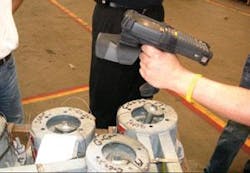Piping Technology & Products Inc. manufactures various metal piping products, such as pipe shoes, pipe hangers, expansion joints, slide plates, etc. for the oil and gas industry. The Houston-based company, in business since 1975, planned to purchase RFID tags to attach to these metal products shipped to their clients’ construction sites. Because the tags would be used in an industrial setting, they needed to be weather resistant and survive harsh environments. In addition, they have to function with large amounts of metal structure surrounding the products. The tags needed to have a long read-range so they could be effectively read when 100 ft above ground, for example.
What type of RFID tag should this company use to fulfill their operational requirements? The RFID and Sensor Research Laboratory at the Industrial Engineering Department, University of Houston, was asked to answer this critical question.
The company had two RFID operational requirements:
- To track inventory in pallets when products are shipped to customers.
- To track individual products attached with RFID tags to be stored and located at various areas of a construction site for installation or part replacement.
Testing
We used two types of RFID tags, passive and active, for testing the two requirements: pallet-level tracking (Fig. 1); and item-level tracking. We conducted the tests at University of Houston’s mockup RFID lab as well as at the company’s manufacturing floor. In addition, the tests of field movement tracking and monitoring of individual products with RFID tags attached were also conducted at a customer’s construction site.
After conducting several tests with different piping products and at various locations, we concluded that:
- Passive RFID tags with foam backing work extremely well for metallic products. Although a 100% reading rate was achieved, the reading range is only about 10-15 ft, which therefore limit its application only to short range reading application, such as pallet level tracking.
- Active RFID tags work well in harsh environments. The reading range is 100300 ft depending on product memory size and vendor. In addition to the fast reading speed, data in transit can also be stored on the tag, and uploaded to a computer server whenever a wireless communication is available and established. Active RFID tags are more applicable for long-range reading applications, such as item level tracking (both on the ground and above the ground), field movement tracking and monitoring of individual product.
Opportunities
Throughout the study of this RFID application, we identified many constraints and opportunities. The first requirement is to find a proper location to install and house an RFID reader. While any RFID tag can be enclosed with a temperature and moisture-proof casing, an RFID reader is harder to protect from heavy rain and hot weather.
The second requirement is the need to handle millions of data points from RFID tags. Hundreds or even thousands of products must be tracked, monitored, and managed. Advanced technology, such as real-time data synchronization and a fusion engine under development at the University of Houston, will be a possible solution.
Many field operators expressed the desire to incorporate a GPS chip into an active RFID tag. Although the cost factor might currently prevent this product enhancement to be widely adopted, the time will come when GPS chips become a commodity and then this advanced feature will be integrated into RFID tags.
Another opportunity identified during the study is to use Wi-Fi (IEEE 802.11)-based RFID tags, instead of regular active RFID tags, for item level tracking. Any 802.11-compatible wireless access point or router used for regular PCs with proper adapter can also be used to read this type of RFID tag. A typical outdoor 802.11n-series access point or router might have 5,000 ft or greater coverage, according to some vendors, and is more suitable for reading Wi-Fi-based tags at wide open construction sites.
The author
Thomas C. Chen ([email protected]) is a research professor in the department of industrial engineering at the University of Houston and director of the RFID and Sensor Research Laboratory. He holds a BS (1968) in industrial engineering from Tunghai University, Taiwan; an MS (1971) in industrial and systems engineering from the University of Pittsburgh; and a PhD (1976) in industrial engineering and management from Oklahoma State University. Chen is a registered professional engineer in Texas.

